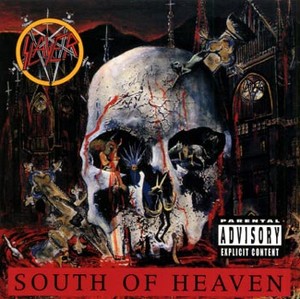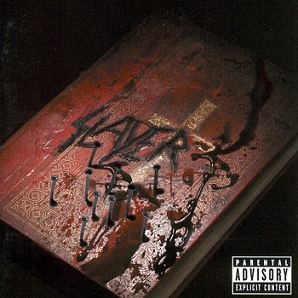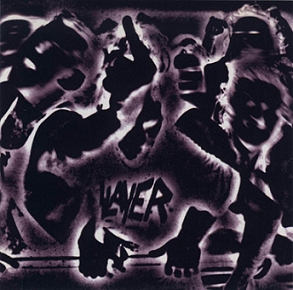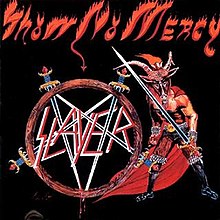
Slayer is an American thrash metal band from Huntington Park, California, formed in 1981 by guitarists Kerry King and Jeff Hanneman, drummer Dave Lombardo and bassist/vocalist Tom Araya. Slayer's fast and aggressive musical style made them one of the "big four" bands of thrash metal, alongside Metallica, Megadeth, and Anthrax. Slayer's current lineup consists of King, Araya, drummer Paul Bostaph and guitarist Gary Holt, who initially joined as a touring member in 2011 before joining the band permanently after Hanneman's death in 2013. Drummer Jon Dette was also a member of the band.

Reign in Blood is the third studio album by American thrash metal band Slayer, released on October 7, 1986, by Def Jam Recordings. The album was the band's first collaboration with producer Rick Rubin, whose input helped the band's sound evolve. The release date of the album was delayed because of concerns regarding the lyrical subject matter of the opening track "Angel of Death", which refers to Josef Mengele and describes acts such as human experimentation that he committed at the Auschwitz concentration camp. The band's members stated that they did not condone Nazism and were merely interested in the subject.

South of Heaven is the fourth studio album by American thrash metal band Slayer, released on July 5, 1988, by Def Jam Recordings. The album was the band's second collaboration with producer Rick Rubin, whose production skills on their previous album Reign in Blood (1986) had helped their sound evolve. Given the frenetic pace of Reign in Blood, Slayer made no attempt to top it on South of Heaven; rather, the band offset and complemented Reign in Blood by deliberately slowing the tempo down on South of Heaven, as well as by utilizing undistorted guitars and toned-down vocals.

Hell Awaits is the second studio album by American thrash metal band Slayer, released on April 8, 1985, by Metal Blade Records. The band's 1983 debut Show No Mercy became Metal Blade Records' highest-selling release, and as a result, producer Brian Slagel desired to release a second Slayer album. To that end, Slagel financed a recording budget and recruited several experienced producers to help in the studio.

God Hates Us All is the ninth studio album by American thrash metal band Slayer, released on September 11, 2001, by American Recordings. It was recorded over three months at The Warehouse Studio in Vancouver, and includes the Grammy Award-nominated song "Disciple". Guitarist Kerry King wrote the majority of its lyrics, taking a different approach from earlier recordings by exploring topics such as religion, murder, revenge, and self-control. Stylistically, the album shows a return to Slayer's classic thrash metal sound. It was Slayer's last album to feature drummer Paul Bostaph until his return on their 2015 album Repentless.
"Angel of Death" is the opening track on American thrash metal band Slayer's 1986 album Reign in Blood. The lyrics and music were written by guitarist Jeff Hanneman. They detail the Nazi physician Josef Mengele's human experiments at the Auschwitz concentration camp during World War II.

Tomás Enrique Araya Díaz is a Chilean-American musician, best known as the vocalist and bassist of thrash metal band Slayer. He was ranked 58th by Hit Parader on their list of the 100 Greatest Metal Vocalists of All Time. Araya, along with Kerry King, are the only members who stayed in the band since its inception.

Undisputed Attitude is the seventh studio album by American thrash metal band Slayer, released on May 28, 1996, by American Recordings. The album consists almost entirely of covers of punk rock and hardcore punk songs, and also includes two tracks written by guitarist Jeff Hanneman in 1984 and 1985 for a side project called Pap Smear; its closing track, "Gemini", is the only original track. The cover songs on the album were originally recorded by the bands the Stooges, Minor Threat, T.S.O.L., D.R.I., D.I., Dr. Know, and Verbal Abuse, whose work was prominently featured with the inclusion of cover versions of three of their songs.

David Lombardo is a Cuban-American drummer, best known as a co-founding member of the thrash metal band Slayer. He currently plays drums with Fantômas, Dead Cross, Mr. Bungle, Empire State Bastard, and Misfits.

Paul Steven Bostaph is an American drummer best known as a member of the thrash metal band Slayer, initially from 1992 to 2001, again from 2013 to 2019, and in 2024, after the reunion. His drumming career began in 1984 when he was 20 years old. In addition to Slayer, he has worked with bands such as Forbidden, Exodus, Systematic, Testament, and BlackGates. Metal-Rules.com describes Bostaph as "a true professional and one of the best drummers on today's metal music scene".

Jeffrey John Hanneman was an American musician, best known as a founding member and guitarist of the thrash metal band Slayer. Hanneman composed both music and lyrics for every Slayer album until his death in 2013.

Eugene Victor Hoglan II is an American drummer, acclaimed for his creativity in drum arrangements, including use of abstract devices for percussion effects and his trademark lengthy double-kick drum rhythms. Though his playing style is very technically demanding, he retains high accuracy at extreme tempos, earning him the nicknames "The Atomic Clock" and "Human Drum Machine".

Haunting the Chapel is an extended play (EP) released by American thrash metal band Slayer in 1984 through Metal Blade and Enigma Records. Slayer's debut album Show No Mercy became Metal Blade's highest-selling, leading to producer Brian Slagel wanting to release an EP. Recorded in Hollywood, the recording process proved difficult when recording drums in a studio without carpet, although it resulted in drummer Dave Lombardo meeting Gene Hoglan who was to become an influence in his drumming style and speed. It was during the recording of this session that Lombardo first had the double bass added to his kit. Hoglan, working for Slayer at the time, sat at the kit and played a double bass for the first time. Lombardo was impressed and although Hoglan never gave him lessons, he did give him tips regarding the use of the double kick drum.

Diabolus in Musica is the eighth studio album by American thrash metal band Slayer, released on June 9, 1998, by American Recordings. Guitarist Jeff Hanneman wrote most of the album's content, which has been described as Slayer's most experimental. It was the band's first album to be played mostly in C♯ tuning, and named after a musical interval known for its dissonance. Lyrical themes explored on the album include religion, sex, cultural deviance, death, insanity, war, and homicide.

War at the Warfield is a concert video by Slayer which was released on July 29, 2003, through American Recordings. Recorded at Warfield Theatre in San Francisco, California, on December 7, 2001, it is the band's second video album. The DVD's contents were announced by MTV on July 25, 2003. It is the last release by Slayer with drummer Paul Bostaph, who left due to a chronic elbow injury. Bostaph was subsequently replaced by the original Slayer drummer Dave Lombardo. War at the Warfield was well received by critics, debuting at number three on the Billboard DVD chart, and sold over 7,000 copies in its first week. It was certified gold by the Recording Industry Association of America (RIAA) for selling over 50,000 copies in the United States. It also won a 2003 Metal Edge Readers' Choice Award for DVD of the Year.

Still Reigning is a live performance DVD by the thrash metal band Slayer, released in 2004 through American Recordings. Filmed at the Augusta Civic Center on July 11, 2004, the performance showcases Slayer's 1986 album, Reign in Blood, played in its entirety with the four original band members on a set resembling their 1986 "Reign in Pain" tour. Still Reigning was voted "best live DVD" by the readers of Revolver magazine, and received gold certification in 2005.
"Jihad" is a song by the American thrash metal band Slayer which appears on the band's 2006 studio album Christ Illusion. The song portrays the viewpoint of a terrorist who has participated in the September 11, 2001 attacks, concluding with spoken lyrics taken from words left behind by Mohamed Atta; Atta was named by the FBI as the "head suicide terrorist" of the first plane to crash into the World Trade Center. "Jihad" was primarily written by guitarist Jeff Hanneman; the lyrics were co-authored with vocalist Tom Araya.

"Eyes of the Insane" is a 2006 song by the American thrash metal band Slayer, taken from their 2006 album Christ Illusion. The lyrics explore an American soldier's mental anguish following his return home from the second Gulf War, and are based on an article entitled "Casualty of War" in Texas Monthly magazine. "Eyes of the Insane" was written by vocalist Tom Araya during pre-production for the album. The song was generally well received by critics, and also peaked #15 on the Danish singles charts.

World Painted Blood is the eleventh studio album by American thrash metal band Slayer. It was released through American Recordings and Sony Music on November 3, 2009 and was produced by Greg Fidelman and executively produced by Rick Rubin. It is the band's only album produced by Greg Fidelman and the last album to feature the band’s original lineup including guitarist Jeff Hanneman and drummer Dave Lombardo. With much anticipation for the album after 2006's Christ Illusion, members of Slayer began revealing information about the album beginning in early 2009.

Repentless is the twelfth and final studio album by American thrash metal band Slayer, released on September 11, 2015. This is the band's first album recorded without guitarist Jeff Hanneman, who died from liver cirrhosis in 2013 and was replaced by Gary Holt. It is also the first album to feature drummer Paul Bostaph since God Hates Us All (2001). Repentless is also the only album the band released on Nuclear Blast and was produced by Terry Date, replacing Rick Rubin after twenty-nine years and nine studio albums as their producer or executive producer. The six-year gap between World Painted Blood (2009) and Repentless was also the longest between two Slayer albums in their career.



















